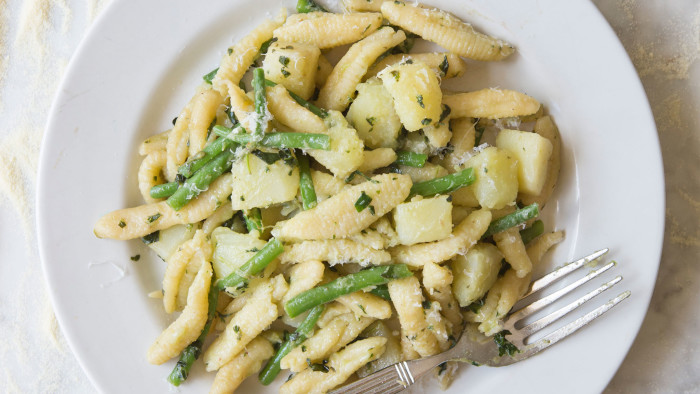Recipe: cavatelli al pesto

Simply sign up to the Life & Arts myFT Digest -- delivered directly to your inbox.
I run into trouble when I pontificate about the food in Liguria. My friend Ruthie Rogers also fell foul of a reader of this paper from that region, for daring to recommend Puglian olive oil, pine nuts from Pisa and very possibly pecorino from Sardinia in her recipe for pesto. The same reader gave me a roasting for calling the spiny lobster in Puglia a cigala, which was probably incorrect, but I was only reporting what the chef in the restaurant called it.
Cavatelli al pesto
Scroll down for method and ingredients
Serves six to eight
So, Liguria: let us tread very carefully here. I will tentatively allege that the really classic pasta with pesto is trofie, hand-rolled little missiles an inch long, fat in the middle and with little trailing tails at each end. They are laborious to make, but I have done so after a couple of hours’ brilliant tuition from Alberico Penati and his brilliant sous chef some years ago in Harry’s Bar. I met the sous chef, Luigi, now in private service, relaxing in the bar at Toto’s, a rather stylish old Chelsea haunt now in the assured hands of the old master of Le Gavroche, Silvano Giraldin.
There was another reminder of Luigi on the menu, in the form of cavatelli al pesto. I was intrigued and had to have it. It was very similar to Luigi’s preparation, the supple pasta tossed with some diced potato and inch lengths of French beans, the whole enrobed in some pungent and verdant pesto. But what was this cavatelli all about? They formed little ribbed, hollow lozenges that collected every drop of sauce. I enquired how they were made and was taken into the kitchen and shown the little machine. Several of the Italian chefs enthused and told me the contraption was easy to get from a certain large online retailer.
The trouble is, cavatelli is not Ligurian. It comes from the opposite end of Italy, in Puglia. This shocking solecism was committed by a bunch of Italians in Knightsbridge. I suppose this is not the best time to remind anyone that there is an awful lot of pesto over the border, not in Liguria, not even in Italy, and there they call it pistou.
Cavatelli al pesto
If you don’t have the machine – and why should you? – but still want to make your own pasta, trofie are the best bet. With the same dough in the same flattened cylinders, simply cut it into little logs and then shape each one between the two bifurcated forefingers to produce little torpedoes. Serves six to eight.
- Mix the flour and salt in a food processor. Pour in the water and work the mixture until it forms an elastic, springy dough. Collect the dough into a mass, sprinkle with a little dry semolina flour, wrap in film and refrigerate for a minimum of one hour.
- Peel the potatoes and cut into centimetre cubes. Cover with salted cold water, bring to the boil and simmer until just tender. Drain and leave to cool. Top and tail the French beans and blanch until al dente in boiling salted water. Drain, leave to cool and cut into lengths of 2cm.
- In a mortar and pestle, pound the garlic with the sea salt to make a fine, smooth paste before adding the pine kernels, basil and garlic. Continue pounding until they too form a paste. Add the oil in a trickle so that it emulsifies the mixture and thicken with the Parmesan cheese at the end.
- To make the cavatelli, cut the dough into 10 pieces and roll them out into long cylinders less than 1cm thick, using semolina flour to stop the dough sticking to the work surface. Run the rolling pin over these cylinders so that they form flat lengths about 1cm wide. Still using the semolina flour, feed these lengths into the machine, turning the feed handle with a slow but very steady rhythm. Take care to keep the formed cavatelli separate, again using a little flour to stop them sticking.
- Bring a large pot of water to a rolling boil with a small handful of salt. Drop the cavatelli into the water and give a gentle stir. Cover the pan momentarily and then remove when the pasta starts to come to the surface. Once it all has, drop in the potatoes and French beans and leave for 30 seconds.
- Drain the contents of the pan into a colander over another pot and transfer the pasta and vegetables to a large, warm bowl. Add the pesto and toss together very thoroughly, adding a little of the pasta water to give a nice coating to all the pasta. Check the seasoning, take to the table and serve with a little extra Parmesan cheese if desired.
Rowley’s drinking choice
A good Vermentino is probably the vin de pays.
Photograph: Andy Sewell
Comments